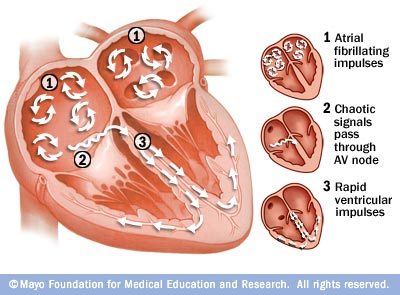Intermountain Medical Center reseachers develop new 3-D technology to treat atrial fibrillation
Researchers at the Intermountain Heart Institute at Intermountain Medical Center have developed a new 3-D technology that for the first time allows cardiologists the ability to see the precise source of atrial fibrillation in the heart – a breakthrough for a condition that affects nearly three million Americans.
This new technology that maps the electronic signals of the heart three dimensionally significantly improves the chances of successfully eliminating the heart rhythm disorder with a catheter ablation procedure, according to a new study presented at the Heart Rhythm Society’s National Scientific Sessions in Denver on Saturday, May 11, 2013.
Atrial fibrillation occurs when electronic signals misfire in the heart, causing an irregular, and often chaotic, heartbeat in the upper left atrium of the heart.
Symptoms of atrial fibrillation include irregular or rapid heartbeat, palpitations, lightheadedness, extreme fatigue, shortness of breath or chest pain. However, not all people with atrial fibrillation experience symptoms.
“Historically, more advanced forms of atrial fibrillation were treated by arbitrarily creating scar tissue in the upper chambers of the heart in hopes of channeling these chaotic electrical signals that were causing atrial fibrillation,” said researcher John Day, MD, director of the heart rhythm specialists at the Intermountain Heart Institute at Intermountain Medical Center. “The beauty of this new technology is that it allows us for the first time to actually see three dimensionally the source of these chaotic electrical signals in the heart causing atrial fibrillation.”
Previously, cardiologists were able to map the heart in 3-D to enhance navigation of catheters, but this is the first time that they’ve utilized 3-D imaging technology to map the heart’s specific electronic signals. Armed with this information, cardiologists can now pinpoint exactly where the misfiring signals are coming from and then “zap” or ablate that specific area in the heart and dramatically improve success rates.
Atrial fibrillation facts
Atrial fibrillation is an abnormal rhythm of the heart.
Atrial fibrillation is caused by abnormal electrical discharges within the atria.
Atrial fibrillation reduces the ability of the atria to pump blood into the ventricles and usually causes the heart to beat too rapidly.
Symptoms of atrial fibrillation include palpitations, dizziness, fainting, weakness, fatigue, shortness of breath, and chest pain although some people have no symptoms.
Complications of atrial fibrillation include heart failure and stroke.
Atrial fibrillation can be diagnosed by physical examination, electrocardiogram, Holter monitor, or patient-activated event recorder.
Treatment of atrial fibrillation is directed toward controlling underlying causes, slowing the heart rate and/or converting the heart to normal rhythm, and stroke prevention using blood-thinning medications.
Medications are commonly used in the longer term to control or prevent recurrence of atrial fibrillation, but medications may not be effective and may have intolerable side effects.
Electrical cardioversion is successful in over 95% of patients with atrial fibrillation, but 75% of patients have a recurrence of atrial fibrillation within 1 to 2 years.
Some doctors may leave patients in atrial fibrillation for the longer term provided the heart rate is under control, blood flow is adequate, and blood is adequately thinned with medications.
Non-medication treatments of atrial fibrillation include pacemakers, AV node ablation, atrial defibrillators, and the Maze procedure.
Pulmonary vein isolation shows promise for the treatment of atrial fibrillation and has a high rate of success; however, longer-term experience is necessary.
With this new technology, cardiologists will now be able to treat thousands of more patients who suffer from advanced forms of atrial fibrillation and were previously not felt to be good candidates for this procedure.

“The capabilities of the new technology can be compared to a symphony concert,” said Jared Bunch, MD, medical director for electrophysiology research at the Intermountain Heart Institute at Intermountain Medical Center. “During the concert, you have many different instruments all playing different parts, much like the heart has many frequencies that drive the heartbeat. This novel technology allows us to pinpoint the melody of an individual instrument, display it on a 3-D map and direct the ablation process.”
The research team used the new 3-D mapping technology on 49 patients between 2012 and 2013 and compared them with nearly 200 patients with similar conditions who received conventional treatment during that same time period.
About one year after catheter ablation, nearly 79% of patients who had the 3-D procedure were free of their atrial fibrillation, compared to only 47.4% of patients who underwent a standard ablation procedure alone without the 3-D method.
“This new technology allows us to find the needles in the haystack, and as we ablate these areas we typically see termination or slowing of atrial fibrillation in our patients,” says Dr. Day.
All of the patients in the study had failed medications and 37 percent had received prior catheter ablations. The average age of study participants was 65.5 years old and 94 percent had persistent/chronic atrial fibrillation.
Previous research has shown that the incidence of atrial fibrillation increases with age. A report from the American Heart Association shows the median age for patients with atrial fibrillation is 66.8 years for men and 74.6 years for women.
If untreated, atrial fibrillation can lead to blood clots, stroke and heart failure. In fact, people with atrial fibrillation are five times more likely to have a stroke than people without the condition.
Intermountain Medical Center is the flagship facility for the renown Intermountain Healthcare system.
###
Jason Carlton
.(JavaScript must be enabled to view this email address)
801-507-7454
Intermountain Medical Center